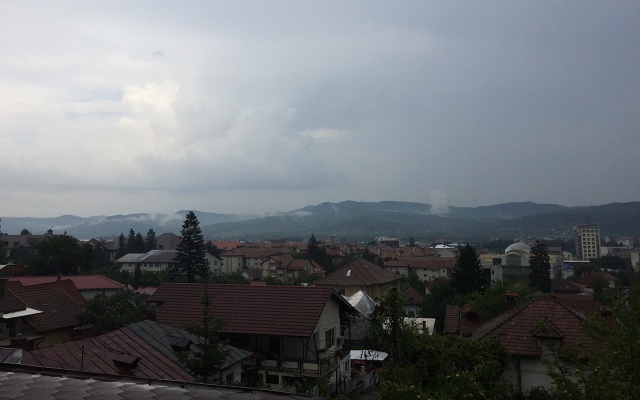Hackerville, a Romanian-German television series debuted in 2018, making headlines as HBO Europe’s first co-international production. The series features a German-Romanian detective who returns to her Romanian hometown to track down a ring of dangerous cybercriminals. Some of these hackers are just kids having fun trying to make quick money, and some are part of a nefarious international cybercrime network. Created by Ralph Martin and Jörg Winger, the series also explores the repressive socialist regime and the secrets it transposes into the present. Most of the first season takes place in the contemporary Romanian city of Timișoara. However, “Hackerville” as a geographic descriptive generally refers to the smaller mountain city of Râmnicu Vâlcea, which in 2011, Wired famously described as “Cybercriminal Central.” Then, in 2015, perhaps as a prelude to HBO’s Hackerville, a short film depicted the dangerous hackers of Râmnicu Vâlcea, entitled, The Most Dangerous Town on the Internet: Where Cybercrime Goes to Hide. Produced by the Silicon Valley cybersecurity firm, Norton Security and directed by Sean Dunne, the film depicts Romanian hackers in dark, communist-era crumbling buildings, threatening to hack the entire planet. Its purpose is to warn viewers of Hackerville’s perilous cybercriminals and to thereby usher them into buying Norton’s Symentec security product – the ultimate technocapitalist plot.

Most w Râmnicu Vâlcea. Zdjęcie: Nicoleta Moise.

Plan Timișoary. Zdjęcie: Nicoleta Moise.
Unlike the fictional Hackerville, this latter Norton Security film is based upon actual hackers, many of whom have since been apprehended, some of whom were offered plea deals to work for cybersecurity firms. Hackers such as Guccifer (who famously hacked Hillary Clinton, George W. Bush, Colin Powell, and more), Iceman (who hacked NASA), and Tinkode (the most wanted hacker of 2012) are interviewed, along with some anonymous scammers, all of whom are juxtaposed by harrowing police narratives, the ramblings of a somber priest, and the authoritative voice of Norton’s all-knowing head of security, Kevin Healy. As captions ominously warn in the beginning, “Last year, over a billion dollars was stolen by Romanian hackers. Everyone knows what is happening, but omerta, the code of silence, is the norm.” As is inferred, the Silicon Valley cybersecurity company is here to save innocent Americans from the most dangerous town on the internet and its code of silence.
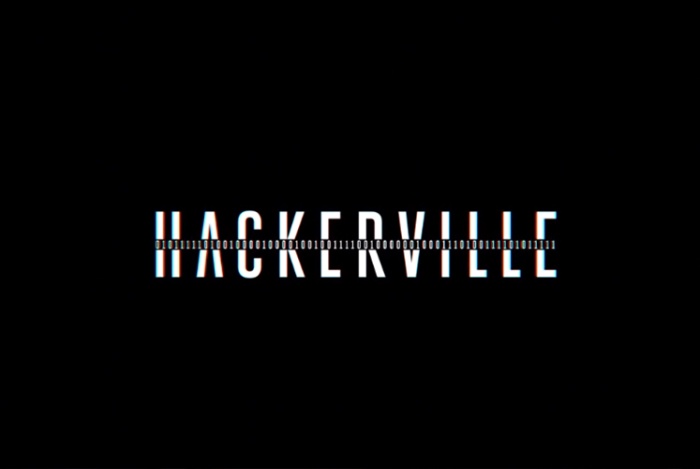
Plansza tytułowa serialu Hackerville.
This framing pairs with the contemporary “Cold War 2.0” Russophobic characterization of Eastern Europe and Russia as threatening to take down US democracy (i.e. RussiaGate), as well as with Silicon Valley narratives that Western technology is inherently more advanced than that of the former second and third worlds. Both Norton’s supposedly non-fictional film, and HBO’s fictional Hackerville, are both caught up in this fiction. Both code socialism and its technological remains as backwards, corrupt, and contaminated. Neither adequately question why technological prowess came to be in postsocialist space, nor what cultural forms hacking networks produce. In this way, both filmic pieces are written from the simplified perspective of the Western Cold War victors, streamlining socialist-era and transitional technopolitics into a pro-capitalist plot. This thereby justifies Western technological intervention. At the same time, both attribute Romania’s cybercriminality to some combination of postsocialist corruption, mafia rule, fast internet, and poverty, but barely interrogate how and why Romania’s technological prowess and infrastructure came to be. Here I suggest that critical and grounded approaches are needed in order to decipher frameworks of postsocialist corruption – politically and computationally.
In Norton’s film, Nicolae Stănculescu, a former Communist authority figure in Râmnicu Vâlcea, attempts to contextualize the city’s proliferation of hackers. “The legacies of communism are complex,” he suggests. “Many of the burdens from that regime still dominate aspects of people’s lives. Important changes took place, especially in the 1980s and 1990s when Romania went crazy resulting in the creation of the so-called new human.” Madalin Dumitru, a Romanian IT security specialist and founder of Cyber Smart Defense, offers: “Because under communism, we were quite limited. We didn’t have so many gadgets. We didn’t have so much access to technology. And since 1989, since the Romanian revolution, the Romanians started to have access to this technology, and they started to develop more and more. They were hungry for IT and for technology.” While these narratives do attempt to contextualize postsocialist-era hacking upon a socialist-era palimpsest, they, like Western Cold War narratives, reify socialism and the transitional period as technologically bleak and underdeveloped. This feeds into Romania’s contemporary so-called Light Revolution/Rezist, which gained international recognition in 2017 for protestors’ use of Western technology to disavow the dark, socialist past and political corruption, and, in doing so, return Romania to its putatively rightful place in the European/Western body. This framing produces an anticommunist timeline, pathologizing all that transpired during the socialist period. In this chronology, the pre-socialist era when Bucharest was “The Little Paris of the East” is worshipped, as is the contemporary moment when Romanian cities such as Cluj-Napoca are gaining traction as “The Silicon Valley of Eastern Europe.” Both geographic comparisons play into longstanding desires throughout Eastern Europe to be seen as fully European. Ousting the remnants of socialist retrograde are integral to achieving this. This plays into Cold War 2.0 narratives, and into the Western framing of Romanian cyberculture as corrupt.

Nowe technologie na ruinach socjalistycznych fabryk. Zdjęcie: Erin McElroy.
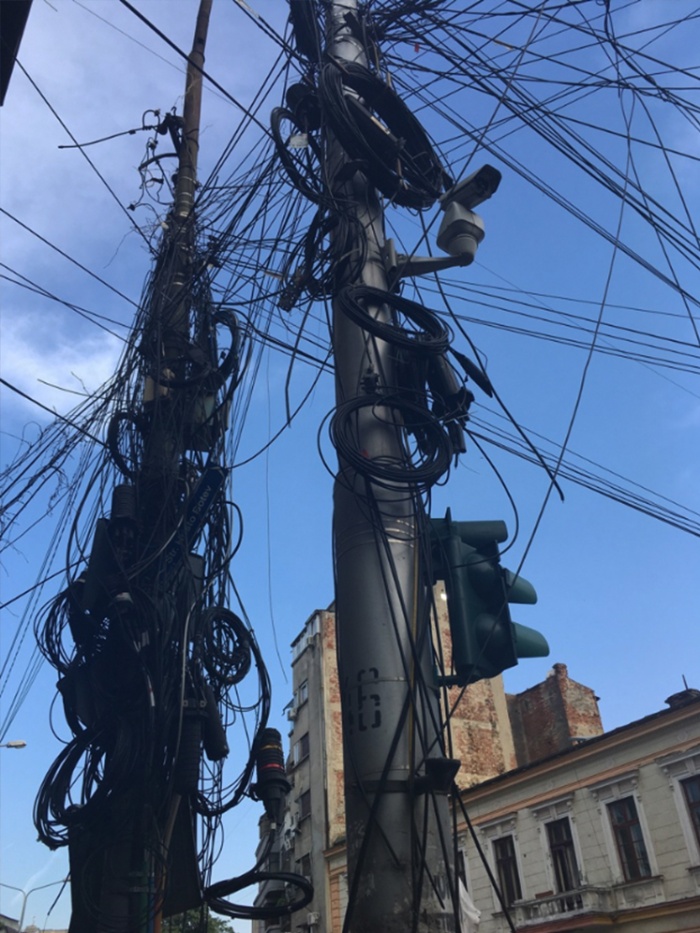
Zrób to sam.Pomysłowość i technokultura ery transformacji. Zdjęcie: Erin McElroy.
While I’m not saying any of this to dive head first into the camp of socialist nostalgia, nor to deny the very real existence of political corruption in postsocialist contexts, I am wary of how such temporal and technological imaginaries bolster the visions of technocapitalism and US imperialism, what I elsewhere describe as Silicon Valley imperialism. By this, I refer to the penetration of Silicon Valley logics, epistemologies, and desires into everyday life globally in modes that reproduce the Valley’s futurity. This relies upon the erasure of techno pasts and futures illegible to its own logics, including those of the socialist and postsocialist cyber deviancy. Silicon Valley imperialism also prefers to understand Eastern Europe as more corrupt than itself, playing into Cold War 2.0 mythologies. Yet from the Cambridge Analytica scandal (which revealed that Facebook was just as, if not more, culpable in skewing the 2016 US election results than Russia and its Guccifer 2.0), to ongoing abuses of artificial intelligence, machine learning, exploitation, and data colonialism being employed by Big Tech, global corruption’s technological epicenter is clearly not Romania.
This isn’t to deny the presence of Big Tech in Romania. Today, Western firms from Oracle to IBM maintain outsourcing firms in the country. German, French, British, and Japanese companies, among others, too have jumped into the scene, eager to capitalize upon Romania’s technological prowess, cheap costs of labor and living, fast internet, and peripheral status in the European body. Google, Microsoft, Accenture, and even Ikea have begun to pinkwash Bucharest’s pride parades, much as they have done elsewhere. Romania boasts its own startups as well, many (though not all) of which receive funding from the West, and many of which are connected to tech hubs, coworking spaces, and larger offices that sit upon the remains of socialist-era factories. There, many friends of mine work night shifts, answering calls and performing medial tasks for Western firms, engaging in what Mary Grey and Siddharth Suri describe as “ghost work.” But still, this doesn’t explain how or why Romanian technological prowess came to be, nor why it has been so simultaneously desirable (outsourcing) and horrifying (hacking) to the West.
Ignored by Hackerville, Silicon Valley, and Light Revolution myths alike is that Romania excelled in hardware production, both above and below ground during socialism, and that the DIY technoculture only proliferated post-1989. The reasons for this are complex and uneven, but here are some broad sweeps that are important in analyzing Romania’s technoculture. To start, during socialism, Romania partially broke from the Soviet Union’s socialist trade bloc, Comecon, due to the country’s desires to do more than produce agriculture for the bloc as prescribed. Instead, it wanted to urbanize, industrialize, and to engage in informatics and computer production. By the 1980s, Romania was producing the most third generation computers in the Eastern bloc, outside of the Soviet Union, selling machines to China and the Middle East. By the time of socialism’s collapse, Romania had manufactured over twenty-five computer models, largely by hacking and altering Western ones. Most famously, France had offered Romania the license for its IRIS-50 model, which Romania then altered, creating the FELIX C-256, and soon a whole generation of FELIX computers. Other home computer (HC) models such as PRAE and CoBra were also manufactured by the state, largely by cloning the British Sinclair ZX Spectrum.
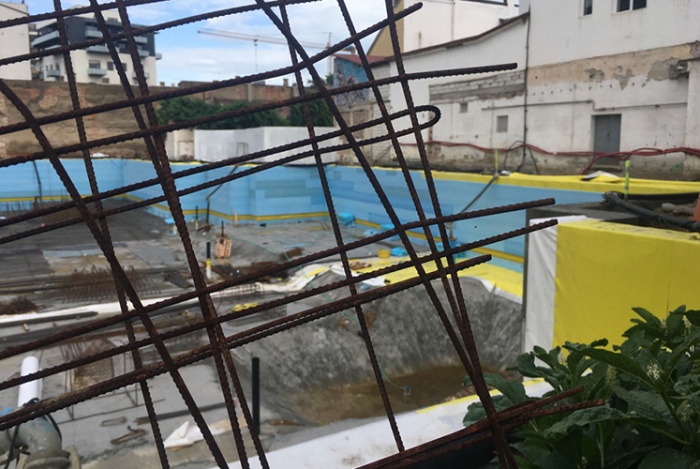
Nowe inwestycje na ruinach socjalistycznych fabryk. Zdjęcie: Erin McElroy.
But computer cloning was not limited to the state, particularly regarding Spectrums. The ZX Spectrum was built in Britain in 1982, and soon after was copied and produced throughout Eastern Europe. While Romania produced Spectrum clones, they were expensive and difficult to obtain, so an underground cloning world proliferated. In Bucharest, this was centered around the Polytechnic University, as Andrada Fiscutean has well documented. As many university students joked throughout the 1980s, more CoBras than the factories did. The 8-bit cloned HC ran a BASIC interpreter, making it relatively easy to use if plugged into a TV monitor. Each was unique, each made from an array of assembled parts and DIY welds. A friend of mine’s brother, Tibi, cloned his own Spectrum and self-taught himself BASIC programming in the 1980s. As he recounted to me one morning, the Communist Party would broadcast code on Thursday evenings at midnight, and Tibi and his friends would record the code on floppy disks and spend the week decoding it. “It was just for fun, but it was how we learned.” Some university students began to engage in hacking with these learned skills, but mostly just for play.
Everything changed after 1989, but not quite in the ways that Norton’s menacing film portrays. For one, following the collapse of socialism, the land that factories (computer and otherwise) sat upon was predated upon by real estate speculators, who parceled it into joint stock trades for profit. Western firms such as IBM, Hewlett Packard, Microsoft, and Oracle rushed into to absorb IT workers, while other programmers migrated to the West. IBM began to sell its own machines, but its plan failed at first, as no one could afford to buy them. Instead, people continued to fabricate their own computers, using parts from wherever they could find them. A decade later, this DIY ethos transcended into the realm of internet networking, with neighbors setting up “block networks” rather than subscribing to larger plans and systems. These networks were often run by youth, who would wire hundreds of meters of cable in order to connect anyone who wanted in. (Since then, they have all been bought up and devoured by three larger companies.) Internet cafes soon sprung up too throughout the country. A friend of mine from Râmnicu Vâlcea, Alex, remembers a zillion internet cafes springing up overnight. “It was hard to get into them because they were so crowded,” he recounted to me one evening at the feminist, anarchist bar where he worked. Mostly people were just playing games and downloading software, he remembers. In 2014, Romania’s piracy rate was twice that of the European Union, at 60 percent, but before, that, in 1996 it was as high at 86 percent. Pirated software was not sold for profit at first, and rather was understood as education, building collective knowledge. This changed after inflation skyrocketed to 151 percent in 1997, when life became tougher.
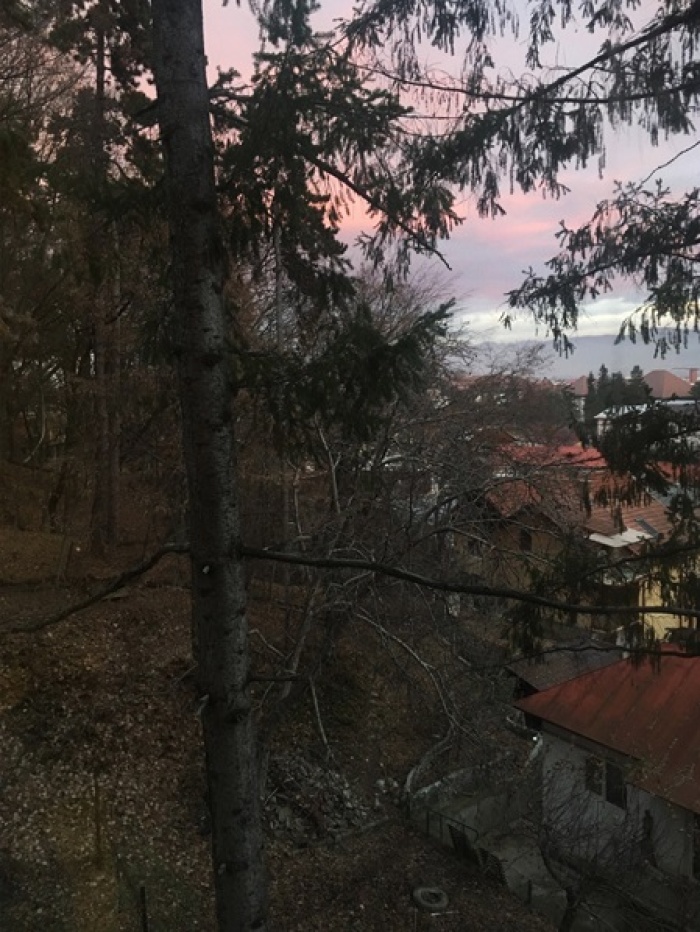
Widok z hotelu Panorama. Zdjęcie: Erin McElroy.
Some of Alex’s memories of Râmnicu Vâlcea hacking found their way into a recent theater play produced by David Schwartz about 1990s hacking culture in Râmnicu Vâlcea, Portofele Virtuale (Virtual Wallet). The opening of the play begins in 2004, and features two ten-year-old friends, Ștefan and Cătă, from a quiet neighborhood known as Tic Tac. The play details the arrival of internet cafes in their neighborhoods, where the youth would congregate to play games such as Counterstrike, not so differently than the internet café portrayed in HBO’s Hackerville. At one point, Ștefan’s older upstairs neighbor, Viorel, began asking Ștefan to translate for him online. Soon, Ștefan was making loads of money. But even then, as Ștefan notes, he had no idea what a hacker was. “I know the word, in English, but what is a hacker?” he asks the audience. While Viorel was eventually apprehended and jailed, Ștefan continued with this life, unaware that he himself had even been a hacker from “the most dangerous town on the internet.”
Other stories detailed in Portofele Virtuale are less playful. The last act features an activist hacker who took down servers in Spain and Italy when they began circulating racist messages that Romanian immigrants working abroad should have their hands cut off (a sentiment most often directed towards Roma Romanians.) The hacktivist himself had parents working abroad, a common trend in Romania, a country depopulating due to economic migration cycles to the West instigating by a lack of opportunity internally. When the authorities come to arrest the hacktivist, even they appreciate him for standing up for Romanians abroad, and pause to take selfies with him before dragging him offstage. Meanwhile, a less grave and perhaps more delightful scene details two scammers in Romania who manage to sell traditional Romanian shirts to two British corporate workers who fetishize Romania’s peasant culture.
These stories depicted by Schwartz (based upon 40 interviews), reveal a complex and entangled picture. For one, in contexts of inequality and poverty, scamming some rich Orientalist Britons for a couple hundred euro, or taking down servers in the name of antiracism, doesn’t read as “dangerous cybercriminality.” On top of that, the characters’ stories are heartbreaking in their own ways, and to understand them, we need to attend to the structural violence of global capital.
Yet for the most part, “hacking” in Hackerville is also about play, curiosity, and as Jaroslav Švelch suggests (of a similar phenomenon in former Czechoslovakia), “gaming the Iron Curtain.” Hacks and games allowed users to communicate and interact with those within and beyond the Iron Curtain and its aftermaths, fomenting unique kinships, most of which were benevolent. As one scammer in Norton’s film describes, “At first, I did everything out of curiosity. Since elementary school, I was among several friends meeting in internet cafes, sharing experiences, and that’s where I first learned how to access servers from abroad.” Sometimes hacks are more malicious, and sometimes more tied to bragging rights or an attempt to make some quick cash. Some scammers have been driven by money, in part reacting to the poverty and austerity that postsocialist transition inhered. Others, such as Guccifer, have been more politically driven and desirous of discovering what he describes in Norton’s film as “the item of truth.” But many have been driven by an entanglement of play, ingenuity, curiosity, activism, and poverty.
Nevertheless, Cold War 2.0 depictions of postsocialist hacking, as in the case of Norton’s film and Hackerville, erase all sociopolitical references as to why technological prowess exists in Romania, and how it produces unique forms of sociality today. Also deleted is any contextualization of why poverty exists in Romania and the role of the West and Silicon Valley imperialism in maintaining it. This erasure helps fuel the mythos of the Cold War 2.0, so that Romania technopolitical landscape can remain a corrupt threat to US democracy – that is, unless one purchases Norton’s security product to protect its users from the most dangerous town on the internet.
BIO
Erin McElroy is a postdoctoral researcher at New York University’s interdisciplinary AI Now Institute, researching artificial intelligence behind property technology. Erin is also cofounder of the Anti-Eviction Mapping Project, a data visualization, digital cartography, and multi-media collective documenting dispossession and resistance struggles upon gentrifying landscapes. Erin earned a doctoral degree in Feminist Studies from the University of California, Santa Cruz, with a focus on the politics of space, race, and technology in Romania and Silicon Valley, and continues to organize with housing justice groups in Romania and the Bay Area today. More recently, Erin co-launched the Radical Housing Journal to foster housing and racial justice transnationally.
* Cover photo: View from Panoramic Hotel in Râmnicu Vâlcea. Photo: Nicoleta Moise.



